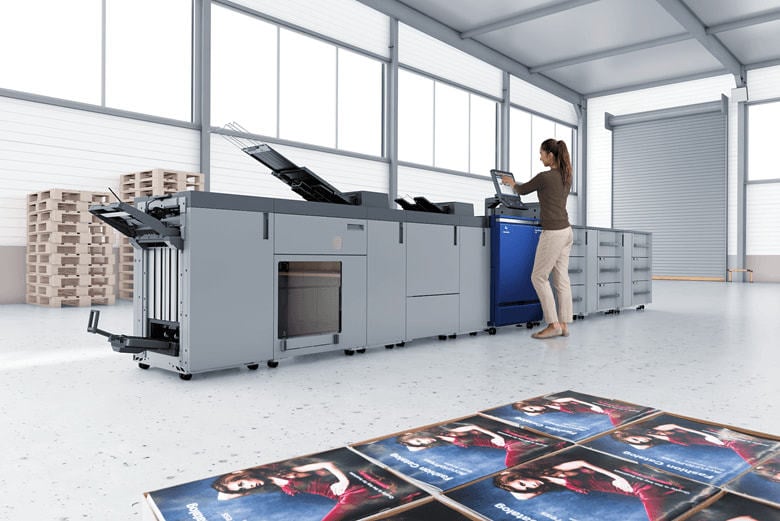Scaling print capabilities over time is essential for growing businesses. However, relying on outsourced offset printing for high-volume print jobs results in increased costs and unnecessary delays.
So how can print shops, schools, hospitals, and other document-heavy businesses scale their print capabilities cost-effectively without sacrificing quality or productivity? Businesses can solve this problem by leveraging cutting-edge digital printing devices including high-quality digital printing presses.
Businesses that choose to invest in an in-house digital printing press will receive various benefits. Digital printing presses provide businesses with convenient, affordable, and efficient ways to print with superior image quality and reliability.
Before diving into the benefits of using digital printing presses, let’s break down the differences between traditional offset printing and sophisticated digital printing.
What are the Differences Between Offset Printing and Digital Printing?
Also referred to as lithography, offset printing is produced on a printing press using aluminum printing plates and wet ink. Offset printing takes longer to produce as there is a longer setup time and since all printed material must dry before final touches can be made. Offset printing works equally well on various material formats, is better suited for higher volume printing, and can produce reliable image quality without streaks or spots. While there are benefits associated with offset printing, there are also significant drawbacks including:
- Longer setup times
- High cost of low-volume jobs
- Significant financial liability if a typo or error occurs
Instead of relying on printing plates, digital printing uses electrostatic rollers called drums to apply toner and color directly onto the media substrate. There are several different types of digital printing devices available including, digital printing presses, digital label presses, and high-speed digital inkjet printers. The elimination of printing plates enables rapid turnaround times and a cheaper option for smaller quantity print jobs. Advancements in digital printing technology are continuously improving print quality and enabling additional advantages including:
- Personalized variable data printing (VDP)
- Cost-effective short-run printing
- Fast turnarounds
- On-demand printing (print the amount you need, when you need it)
How Digital Printing Presses Benefit Document-Heavy Businesses
From reducing print costs to improving turnaround time, here are the top benefits of using a high-quality digital printing press.
Reduces Print Costs
Digital printing presses help reduce overall printing costs by eliminating the need for printing plates, film plates, chemicals, complicated tools, and costly setups required for traditional offset printing. There are also additional labor costs associated with offset printing presses since these complicated machines require skilled technicians to operate. Digital printing presses, on the other hand, are intuitive and easy to use. The simplified printing process eliminates additional labor costs and helps further reduce printer-related costs.
Businesses that invest in digital printing presses will also save money by reducing their energy consumption as these printers use less energy than offset printing presses.
Improves Turnaround Time
Since digital printing presses don’t require printing plates or prepress procedures, the initial setup time is greatly reduced which in turn improves turnaround time. Whether the print job is in color or black and white, digital printing presses are always ready to print short-run jobs at a much faster rate than offset printing presses.
Reliable and efficient digital printing presses help further reduce turnaround time with high-speed output. Konica Minolta’s AccurioPress C14000/C12000 can print 140 pages per minute while maintaining superior image quality with 3600 x 2400 dpi (dots per inch).
Provides More Customization Options
One of the greatest benefits businesses receive when they invest in a high-quality digital printing press is the additional customization capabilities. Businesses can leverage added-value software including variable data software to create individualized printed documents.
Variable Data Printing (VDP) uses cultivated information from a database to enable businesses to customize individual graphics or text on a print-by-print basis without stopping or slowing down the printing process. VDP technology allows companies to create customized mailers on a massive scale and create new opportunities to connect with their customers in a one-to-one way, forging long-lasting relationships and sustained consumer loyalty.
Improve Your In-House Printing Capabilities With a Digital Printing Press
Advancements in digital printing technology have revolutionized the print industry for print shops, schools, hospitals, and other document-heavy businesses. Businesses that choose to invest in a high-quality digital printing press will gain the flexibility to print what they want, in the quantity they want, and when they want it without sacrificing speed, quality, or finishing options.
Businesses that are ready to improve their in-house printing capabilities should talk to a digital printing press specialist to determine which model is the best fit for their high volume, high-quality print projects.



